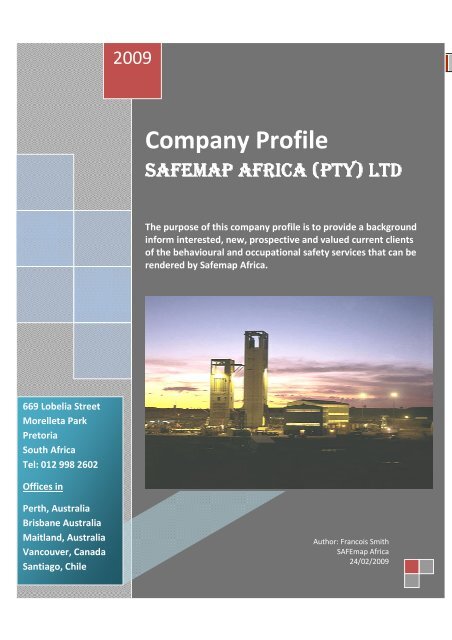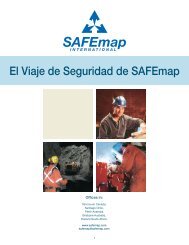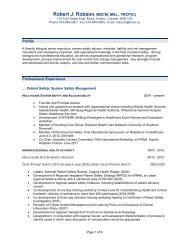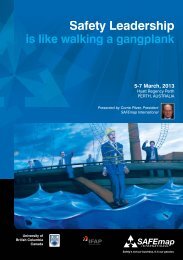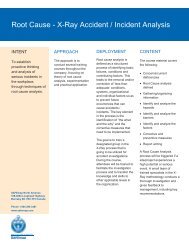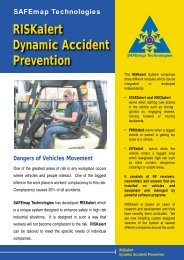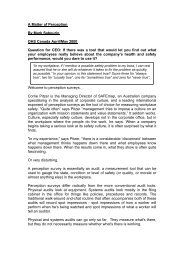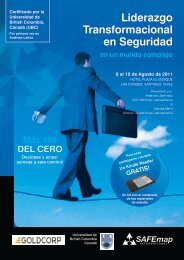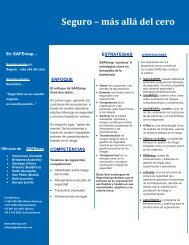Company Profile - SAFEmap International
Company Profile - SAFEmap International
Company Profile - SAFEmap International
You also want an ePaper? Increase the reach of your titles
YUMPU automatically turns print PDFs into web optimized ePapers that Google loves.
2009<br />
<strong>Company</strong> <strong>Profile</strong>: Safemap Africa<br />
<strong>Company</strong> <strong>Profile</strong><br />
SAFEMAP AFRICA (PTY) LTD<br />
The purpose of this company profile is to provide a background<br />
inform interested, new, prospective and valued current clients<br />
of the behavioural and occupational safety services that can be<br />
rendered by Safemap Africa.<br />
669 Lobelia Street<br />
Morelleta Park<br />
Pretoria<br />
South Africa<br />
Tel: 012 998 2602<br />
Offices in<br />
Perth, Australia<br />
Brisbane Australia<br />
Maitland, Australia<br />
Vancouver, Canada<br />
Santiago, Chile<br />
Author: Francois Smith<br />
<strong>SAFEmap</strong> Africa<br />
24/02/2009<br />
1
<strong>Company</strong> <strong>Profile</strong>: Safemap Africa 2009<br />
At <strong>SAFEmap</strong>, through our commitment to safety, we:<br />
<br />
Have become leaders in safety innovation<br />
<br />
Provide an unequalled service on behavioural safety<br />
<br />
Provide a range of other safety management services<br />
<br />
Are specialists in safety culture change<br />
<br />
Conduct advanced safety research projects for industry<br />
Our approach and programs have the following features:<br />
<br />
Sustained and integrated with the client’s systems<br />
<br />
Based on advanced thinking in safety<br />
<br />
Aligned with risk and safety management<br />
<br />
Beyond systems, into winning hearts and minds<br />
<br />
Proven in the mining industry, globally<br />
Supported by specialist in the safety field<br />
<strong>SAFEmap</strong>©2009 2
<strong>Company</strong> <strong>Profile</strong>: Safemap Africa 2009<br />
Contents<br />
1. Introduction ..................................................................................................... 4<br />
2. <strong>SAFEmap</strong> Capability ......................................................................................... 4<br />
3. Industry <strong>Profile</strong> ................................................................................................ 5<br />
4. The <strong>SAFEmap</strong> approach ................................................................................... 6<br />
5. The <strong>SAFEmap</strong> Safety Journey ........................................................................... 7<br />
6. Review of previous and current <strong>SAFEmap</strong> change programs ........................... 9<br />
7. Other engagements……………………………………………………………………………………..11<br />
8. <strong>SAFEmap</strong> expertise ……………………………………………………………………………………..11<br />
9. Resources and personnel in <strong>SAFEmap</strong> ............................................................ 11<br />
9.1 <strong>SAFEmap</strong> personnel ................................................................................. 11<br />
9.2 Associates of <strong>SAFEmap</strong> ............................................................................ 14<br />
10. Training courses offered ………………………………………………………………………………16<br />
11. Other services offered ………………………………………………………………………………...18<br />
12. Basis of costing …………………………………………………………………………………………..19<br />
13. Supporting information ................................................................................. 19<br />
<strong>SAFEmap</strong>©2009 3
<strong>Company</strong> <strong>Profile</strong>: Safemap Africa 2009<br />
1. Introduction<br />
<strong>SAFEmap</strong> Africa is interested in working with prospective or current clients in a partnership to deliver<br />
certain risk and safety management services within a mutually beneficial cooperation agreement. This<br />
profile outlines our capability and experience in the resources and other industries and in safety. The<br />
<strong>SAFEmap</strong> approach is also discussed. Specific interventions by <strong>SAFEmap</strong> are outlined in the six<br />
improvement areas in safety identified through years of research and experience.<br />
Francois Smith (MD) will take overall management responsibility for the Client/<strong>SAFEmap</strong> partnership<br />
and be available to commence work as and when agreed.<br />
<strong>SAFEmap</strong> offers advanced and unique approaches to safety, leading the field of safety with new<br />
models, techniques and with international recognition.<br />
2. <strong>SAFEmap</strong> Capability<br />
<strong>SAFEmap</strong> <strong>International</strong> was founded in 1992 and has achieved significant success in the resources<br />
industry, where it specialises in a unique approach to safety: risk competency. <strong>SAFEmap</strong> has since grown<br />
into an internationally recognised leader in the organisational and individual behaviour management<br />
field.<br />
<strong>SAFEmap</strong> Africa is an Empowerment <strong>Company</strong> registered in July 2003, mainly because of extended<br />
interests of <strong>SAFEmap</strong> <strong>International</strong> into Africa and South America.<br />
<strong>SAFEmap</strong> is a flexible organisation that, through a number of associates and alignments, can deliver<br />
services to small and large organisations alike. Five continental and four regional offices are operated<br />
globally, namely for Western and Southern Australia from Perth, the Australian East Coast and South<br />
Pacific from Brisbane, Africa from Pretoria, Latin America from Santiago, Chilli and North America and<br />
Europe from Vancouver in Canada.<br />
<strong>SAFEmap</strong> has an outstanding record in the field of organizational and individual behaviour modification<br />
at all levels in the organization with blue chip companies such as Placer Dome Global, Xstrata PLC, BOC<br />
Australia, Debswana Mining in Botswana and Afrisam Cement in South Africa.<br />
<strong>SAFEmap</strong> operates offices as partnerships around the world:<br />
• <strong>SAFEmap</strong> Internal holding company, managed by Corrie Pitzer<br />
• Latin America, managed by Alejandro Steinhaus<br />
• Central America, managed by Rene Valle<br />
• Brazil, managed by Jorge Burgos<br />
• South Africa for Africa and Middle East, managed by Francois Smith<br />
• Australia (Western Australia and SE Asia), managed by Rawden Hill<br />
• Australia, (Eastern Australia and Asia), managed by Dave Olive<br />
• North America, managed by Marius Jacobs<br />
The partners in <strong>SAFEmap</strong> are all highly qualified and experienced in fields of safety, risk and behavioural<br />
psychology, and in complementary fields of safety systems, change management, project management,<br />
risk management and risk engineering, as outlined further in this document.<br />
<strong>SAFEmap</strong>©2009 4
<strong>Company</strong> <strong>Profile</strong>: Safemap Africa 2009<br />
3. Industry <strong>Profile</strong><br />
<strong>SAFEmap</strong> specialises in the field of safety culture change and has achieved significant success with<br />
clients such as Goldcorp, Kinross Gold, BOC Gases, Xstrata, Sandvik, Holcim Cement (now Afrisam),<br />
Procon Group, Placer Dome Inc (now Barrick Gold), Petronas, Debswana/DeBeers, Breakwater<br />
Resources and many others over the past 15 years.<br />
<strong>SAFEmap</strong> has an initial background in conducting mine safety culture surveys and related research<br />
programs. In 2000 it was selected by the Minerals Council of Australia to conduct a safety culture survey<br />
of the Australian mining industry and in 2004 by the South African Chamber of Mines to conduct a<br />
similar survey of the South African mining industry. Corrie Pitzer also conducted several studies, in 1998,<br />
for the NSW Department of Mines on mine worker risk-taking behaviours, mine disasters and mine<br />
safety systems.<br />
<strong>SAFEmap</strong> has a long and proven track record of success and impact on industry safety and many<br />
referees comment favourably about our work, amongst others:<br />
Gordon Thompson, Chief Operating Officer, CAMEC Africa, previously Executive Director, South Deep<br />
Francois, have you been watching our safety results? I can’t really ascribe the sudden improvement to anything<br />
other than a change in the consciousness towards the <strong>SAFEmap</strong> process we have embarked on! The number of lost<br />
day accidents has dropped from an average of 11 LDI’s per week to 3 for the last 3 weeks – this last week we<br />
suffered a single LDI, (a silly one which I argue should have been a treat and return – but never the less he still<br />
suffered an injury!)<br />
More importantly I would like to share what one of my executives stated this morning at a Strategic session and<br />
that was: “I believe we are on the right track as far as this Health and Safety stuff is concerned – for me it has<br />
substance and not the stuff that was served up at the other operations I worked at!”<br />
Steve Reid, Chief Operating Officer, Goldcorp, Inc<br />
“The <strong>SAFEmap</strong> expertise in strategic safety management, leadership development and translation of systems to the<br />
workface is unequalled. I have seen it changing behaviours, motivations and performance.”<br />
Dale Ekmark, General Manager, Placer Dome, Debswana/DeBeers, (now GM Kazakhmys inc)<br />
“The <strong>SAFEmap</strong> leadership development process drives significant and measurable performance improvement, not<br />
only in safety but in all organizational outputs. I have managed organizations where the powerful impact of<br />
<strong>SAFEmap</strong>’s ‘transformational leadership’ was clearly visible and evident in our improvements. We deployed worldwide<br />
with outstanding results. I have personally witnessed spectacular results from Tanzania to Papua New Guinea<br />
to North America.”<br />
Tony Gibbs – Group Risk Manager (PPC)<br />
Hi Francois and the <strong>SAFEmap</strong> team, Thank you all for the effort you put in to the training conducted at our sites.<br />
From the feedback this has been some of the best training our team members have experienced. As the saying<br />
goes “it has been a pleasure doing business with you”.<br />
Dan Allan, President, Sandvik Mining and Construction, USA& Mexico,<br />
“<strong>SAFEmap</strong>’s approach to management is unique and conceptually very progressive – it is where we should be in the<br />
mining industry. Corrie leads a team of outstanding professionals and I believe he and <strong>SAFEmap</strong> can add<br />
tremendous value to any organization. They have to ours.”<br />
<strong>SAFEmap</strong>©2009 5
<strong>Company</strong> <strong>Profile</strong>: Safemap Africa 2009<br />
Rodney Stuparyk (Centerra Gold)<br />
“The <strong>SAFEmap</strong> programs have been installed in our Russian-speaking environment and with remarkable acceptance<br />
- in an environment where such acceptance is very rare. <strong>SAFEmap</strong>’s capability to operate in different cultures is<br />
unquestionable”<br />
Rogers Thusi, Debswana / De Beers<br />
The course was very enjoyable and extremely valuable. At no time did I doze off and I am the oldest member of the<br />
team! I think the whole arrangement was superb, from the venue, the food to the exercises. Using the team to<br />
teach each other was most innovative and we learnt from each other a lot more then than we did before. What I<br />
enjoy most about the course is that it not only claims to be an integral part of operations management and<br />
leadership, but it actually is part of operations management and leadership.<br />
4. The <strong>SAFEmap</strong> approach<br />
The <strong>SAFEmap</strong> approach to safety can best be described as “competency-based safety”. This unique<br />
approach was developed over 15 years of extensive research in the mining industry to address<br />
fundamentals of mine safety:<br />
In safety, the first challenge is to achieve a common language. The term ‘safety’ means different things<br />
to different people, but essentially it captures an ideal of ‘absence of harm’. It becomes a little more<br />
difficult if it means ‘absence of failures’ and really complex if it means ‘absence of risk’. It is essential to<br />
establish a common belief about the paradigms of safety and a common understanding of what<br />
‘excellence’ in safety really means, especially to the employee at the face. Without a shared vision, it is<br />
improbable, even impossible, that the organisation will be able to start the journey towards ‘excellence<br />
in safety’.<br />
The <strong>SAFEmap</strong> vision of an ideal organization is one where safety is eventually invisible. There are no<br />
posters, campaigns, targets or safety programs. Production and safety are seamless, with no ‘safety<br />
meetings’, no special committees, no separate points on agendas for safety and line management is<br />
truly accountable for safety. It is an organisation that does not investigate the causes of an accident, but<br />
analyses risk. It is an organisation that allows, elicits and rewards innovation, for which it must endure<br />
error, but not tolerate blunders.<br />
Developing the value-driven organisation is a process that takes time and executive accountability and<br />
there are three pre-requisites to develop the conviction that will result in action to work safely, as an<br />
individual, team, site or corporation. Firstly the anticipation skills and analysis of risks, secondly the<br />
motivation to take action and thirdly the integration of safety and operational processes.<br />
It is a complex and difficult road to travel for any organisation, with a stark reality: the goal will never<br />
‘finally’ be achieved, because, by definition, the journey can never end. Thus, safety is not defined by<br />
the absence of a number (zero accidents), but defined by the presence of Energy, Motivation and<br />
Competence (E=mc²!). The quest for a powerful and caring safety culture may not eliminate all injuries<br />
from our work places in the short term, but it gives the best possible chance to do so over the long term.<br />
Many safety researchers have identified human error, or risk-taking, as the biggest contributor to<br />
accidents and incidents. One of the earliest safety management specialists, HW Heinrich, indicated that<br />
85% of all accidents are “human-related”. For many years after that, the approach was mostly to train,<br />
instruct and to enforce rules. The American behavioural models became very popular in the safety<br />
discipline, and developed through various stages. Initially, the three E’s (Engineering, Enforcement,<br />
Education) was the most widely applied model for many decades, and slowly replaced in recent years<br />
with more participative behavioural models, such as achieved through peer observations.<br />
<strong>SAFEmap</strong>©2009 6
<strong>Company</strong> <strong>Profile</strong>: Safemap Africa 2009<br />
However, recent research in the field of behavioural safety and in the field of risk homeostasis suggests<br />
that risk-taking behaviour is a complex phenomenon, and not something that can simplistically be<br />
achieved only through the Antecedent-Behaviour-Consequence (ABC) model of human behaviour. It is<br />
rather surprising that the ABC model is still a popular model, despite the very obvious limitations it<br />
showed in many aspects of safety and risk management.<br />
The <strong>SAFEmap</strong> CBS approach to safety incorporates the most modern techniques of safety management<br />
available today, in our terms: human technology and engineering. It develops competent behaviour in<br />
the workplace through a variety of techniques and introduces a new concept in safety, namely “risk<br />
competence”. Risk competence is based on the premise that all workplaces contain risk to some degree<br />
and that employees will have to take risks in their daily work routine – otherwise they get nothing done.<br />
Instructing employees “not to do a job unless it is safe to do” is obviously a statement designed to<br />
protect management and not the worker. What work will an employee really be able to do that is<br />
“safe”? What is safe and what is safe enough?<br />
When will the employee know that it is safe, especially if a sad fact is that approximately 20% of deaths<br />
in the resources industry occur while employees are doing tasks according to the company’s<br />
procedures?<br />
The <strong>SAFEmap</strong> CBS process develops risk skills to ensure that when employees have to take those risks,<br />
they do so competently. <strong>SAFEmap</strong> provides a balanced focus on behaviour and a total solution of<br />
advanced safety techniques, systems and tools. Behaviour is influenced by both attitudes and risk<br />
perceptions of employees – their mindsets.<br />
5. The <strong>SAFEmap</strong> Safety Journey<br />
Starting the journey<br />
Safety is a journey that starts with a decision and a commitment, but has no end result, no final goal, no<br />
‘condition’ where perfect exists. There is no ‘safety paradise”, no decisive victory.<br />
Safety today…<br />
Safety and risk are often seen as two opposites, where we have to move from a condition of risk<br />
(danger) to a condition of safety (absence of harm). In this approach, we analyze accidents and prevent<br />
them, we set rules and enforce them, we educate our people not to take any risks and we ask them to<br />
identify hazards which we (as management) will eliminate or mitigate. Safety management has moved<br />
on from a dogmatic approach and has become a dynamic process in the modern business environment.<br />
In the first instance, it is no longer a ‘top-down management driven’ approach but one in which all<br />
employees, contactors, service providers and clients participate in.<br />
Risk is recognized as a circumstance that can have a positive outcome or a harmful one, sometimes a bit<br />
of both and that we have to balance those outcomes. If we don’t take risks, we will not achieve, if we<br />
don’t experiment we will not discover and if we don’t innovate, we will recede. We therefore have to<br />
find the fine balance between risks, rewards and potential harm.<br />
The journey ahead…<br />
Safety in these terms is a process through which we seek opportunities in a responsible way, develop<br />
skills in all our people to deal with risks competently, and confidently explore new and better ways to<br />
engineer and build things. It is part of the strategic planning and thinking and is integrated in every<br />
activity. Safety should be integrated in our business so that eventually it will become seamless and an<br />
<strong>SAFEmap</strong>©2009 7
<strong>Company</strong> <strong>Profile</strong>: Safemap Africa 2009<br />
accepted consideration before we make any decision. Line management is truly accountable for safety.<br />
They manage and coach their people to develop competence and reward and recognize them<br />
accordingly, gaining the trust and support of all. Employees will grow from being safe workers to<br />
become safety champions.<br />
• There are several criteria to be met before an organization can truly claim to be innovators:<br />
• They must know and understand their risks, and deal with the facts of risk, not the illusions;<br />
• They must gain the commitment of all;<br />
• They must develop their capabilities.<br />
The above three criteria have complex and demanding implications for each person or business unit.<br />
This requires careful training and deployment of the right resources of money, people and time,<br />
operationally and strategically. It is a difficult road to travel for any organization, with a stark reality: the<br />
goal will never ‘finally’ be achieved, because, by definition, the journey can never end. In this context,<br />
safety isn’t defined by the absence of a number (zero), but defined by the presence of energy,<br />
motivation and competence: the ‘zeniths’ of safety.<br />
Therefore, the quest for a powerful and caring safety culture will possibly not eliminate all injury or<br />
death from our work places in the short term, but it will give us the best possible chance to do so over<br />
the long term.<br />
<strong>SAFEmap</strong>©2009 8
<strong>Company</strong> <strong>Profile</strong>: Safemap Africa 2009<br />
The Safety Growth Model<br />
The Safety Growth Model has been developed by <strong>SAFEmap</strong> for self assessment, international<br />
benchmarking, and ultimately, a roadmap for improvement of safety purposes. Organisations can utilize<br />
the model to honestly and transparently assess their current safety status and to plan improvement<br />
actions that can take them to the next level of safety management.<br />
Very few organizations truly get to the higher echelons of resilient safety management because the<br />
required effort to reach and maintain such a high level of safety performance often seemingly has to<br />
compete directly with production for financial and other resources. The air at such high performance<br />
levels are extremely thin and it takes carefully planned and rigorously implemented actions to move the<br />
organization from “good” to “great” in safety management and performance.<br />
The Safety Growth Model depicts six (6) distinct stages of safety performance which are described<br />
below. There is never a clear cut between these stages and organizations must be brutally honest when<br />
conducting a safety maturity self assessment. It is also true that the exercise is highly subjective since<br />
employee’s perceptions at different levels, departments and positions in the organization varies widely<br />
and are influenced by recent personal observations and experiences.<br />
What does the road look like…?<br />
The road ahead has three lanes:<br />
• The values of the leaders, the organization and of the people have to be aligned and integrated;<br />
• The actions and behaviours of people at all levels of the business have to support the values;<br />
• The central lane is the one in which we have dynamics systems in place to address the dynamic<br />
risks, progressively and proactively.<br />
The <strong>SAFEmap</strong> Vision<br />
Our vision is to support our client’s evolution to an organization where safety is fundamental to what<br />
they do, where we truly care about their people around us and through which they gain global<br />
recognition that they are the best in the business.<br />
6. Review of previous and current <strong>SAFEmap</strong> change programs<br />
<strong>SAFEmap</strong> has achieved many successes with our clients internationally and we proudly announce<br />
them:<br />
Designed and implemented a comprehensive change program at Placer Dome between 2002 and 2005.<br />
At this time the company was taken over by Barrick Gold and they changed direction towards the<br />
Barrick-preferred safety management models. Up to this time, the performance levels of Placer Dome<br />
improved significantly, as measured by lag indicators, lead indicators and safety culture improvements<br />
measured by resurveys. Referees here include executives who are now employed at other companies,<br />
namely John Scott, Group Safety Director, Procon Group, Martin Raffield, now Mine Manager at Myra<br />
Falls Mine, Bob Cutriss, now Technical Manager at Breakwater Resources, Tim Baker: EVP, now COO at<br />
Kinross Gold. Many referees at ex-Placer Dome mines are also available if requested.<br />
Installed change programs at Xstrata mines in South Africa, both Coal and Alloys divisions and achieved<br />
best-ever and best-industry improvements in safety performance. This included leadership<br />
interventions, training and systems deployment and follow-up programs. It also included a deployment<br />
of a powerful risk culture change program called SIXeye on Safety, a process researched and developed<br />
<strong>SAFEmap</strong>©2009 9
<strong>Company</strong> <strong>Profile</strong>: Safemap Africa 2009<br />
by <strong>SAFEmap</strong> over a period of 10 years. Referees here include Sam Coetzer, MD for Xstrata Coal, Ras<br />
Alberts, CEO of Xstrata Coal and Riaan Cilliers, General Works Manager at Rustenburg Smelter.<br />
Currently installing a strategic safety improvement program at Jwaneng Diamond Mine (part of<br />
Debswana/DeBeers Group in Botswana) and deploying multi-level interventions at strategic, tactical and<br />
operational levels. This encompasses a large risk competency training intervention of all employees, as<br />
well as deployment of the <strong>SAFEmap</strong> Safety Leadership Program. Outstanding success has already been<br />
achieved in short time. Referees here include Dale Ekmark, General Manager and Mine Manager J Kirby.<br />
Installed leadership process interventions at Goldcorp, including re-energising the previously installed<br />
behavioural safety process (several Goldcorp mines were previously part of Placer Dome and continued<br />
the <strong>SAFEmap</strong> change programs.) The processes here include the StepBack risk process, 6 Point Safety<br />
System, SAFEaward incentive systems, Safety Coach and Champions program and Master Coach<br />
training. Goldcorp is also deploying the “GOLDENeye-on-Safety” (based on the SIXeye of <strong>SAFEmap</strong>).<br />
The X-Ray system is also deployed - an advanced Root Cause Analysis system that allows organizations<br />
to do accident/incident analysis at all supervisory levels, which can also acts as a risk prediction tool.<br />
Goldcorp is also fully deploying <strong>SAFEmap</strong>’s “Safety Leadership Course”, a course based on the<br />
transformational leadership model of Kouzes and Posner. Referees at Goldcorp include Steve Reid, Chief<br />
Operating Officer; Johan Jacobs, Senior Executive: Training and Development, Marc Lauzier: Safety<br />
Manager, Canadian Operations, and Dan Gagnon, General Manager, Red Lake Mine.<br />
<strong>SAFEmap</strong> Africa is in the process (since Jan 2003) of installing a comprehensive organisation culture<br />
intervention at all sites, factories, mines and depots of Afrisam Cement. The process includes the<br />
development of a three year strategy addressing organizational and safety issues such as<br />
communication, discipline, contractor management, training and the structure and role of the safety<br />
resources and expertise in the company. Referees are Duncan Bosch (project leader) and Charles<br />
Naude, MD of Afrisam South Africa.<br />
<strong>SAFEmap</strong> (North America) recently commenced with programs in at Centerra Gold at mines in<br />
Kyrgyzstan and Mongolia (Susan Mathieu, VP: EH&S) and Kinross Gold (Rick Baker, Sr. Vice President<br />
Environment, Health and Safety) which include various interventions, such as training of leadership,<br />
installing behavioural and risk competency systems and tools at their mines in Brazil, Chile, Russia and<br />
USA.<br />
Nestle Malaysia (9 factories) implemented the program from 1995, achieving significant changes in the<br />
values, beliefs, attitudes and behaviours of employees and managers, with the lead and lag indicators<br />
showing a similar dramatic improvement. Referee is William Kuek, Group SHE Manager.<br />
<strong>SAFEmap</strong> has also conducted major safety culture surveys for clients such as Brambles, Transfield<br />
Services, CSR, BHPBilliton and several other smaller organizations. The e-<strong>Profile</strong> safety culture survey<br />
data base is one of the largest in the world, totalling 75 000 employees from over 200 mining operations<br />
on 5 continents.<br />
Corrie Pitzer has facilitated several high level safety workshops for senior executives of Sandvik Mining<br />
and Construction in North America, and conducted a behavioural safety workshop for the “Round Table”<br />
of North American mining companies, including executives from Newmont, Placer Dome/Barrick, Phelps<br />
Dodge, Inco, and Falconbridge (Xstrata) in Reno, Nevada in 2005.<br />
Other referees in South America include: Codelco Chile, SCM El Abra (now Freeport), Cemento Melon<br />
(Lafarge) in Chile, Petrobras Energía in Argentina, AES, Cerro Vanguardia, Central Puerto, Gas Andes,<br />
Anglo American in Chile, Cia. Minera Zaldivar<br />
Detailed contact information for each of the above named referees is available on request.<br />
<strong>SAFEmap</strong>©2009 10
<strong>Company</strong> <strong>Profile</strong>: Safemap Africa 2009<br />
7. Other Engagements<br />
Safemap is currently engaged with a number of smaller projects and services at various organisations.<br />
• Presenting safety learnerships for the Master Builder’s Association and Transnet Freight Rail;<br />
• Conducting Board of Inquiries into all Transnet fatal incidents;<br />
• Contractor management for Sephaku Cement and Limpopo Roads Agency;<br />
• Safety and risk management training for Hullets Tongaat, Hullamin, Xstrata Coal and Alloys,<br />
Lafarge, PPC, Afrisam and a host of smaller companies;<br />
• New engagements with Lonmin, SA Mint; Redpath Mining, the Mining Qualifications Authority,<br />
Grinaker LTA, Goldfields and Anglo Gold Ashanti.<br />
8. The <strong>SAFEmap</strong> expertise<br />
<strong>SAFEmap</strong> is comprehensively experienced in working in a variety of cultures and able to translate our<br />
unique concepts and skills into those environments – at all levels of organizations. We have ‘translated’<br />
our unique approaches to safety in Australian, African (RSA, Botswana, Tanzania), Asian (Malaysia,<br />
Indonesia, PNG), Russian, North and Latin American cultures.<br />
We have high level skills within our team of safety professionals who are dedicated to ideals of safety<br />
excellence, first and foremost. All senior partners are graduates at Master level, in safety science,<br />
business management and industrial psychology.<br />
Our approach is one of “gradual concept and skill transfer” to the client, simply because the best chance<br />
of success in safety improvements comes from client ownership and belief in the change process –<br />
which ensures <strong>SAFEmap</strong>’s success and credibility in the market place.<br />
Our primary skill is our ability to analyse, conceptualize and diagnose safety processes and dynamics.<br />
Our partners have participated in the Minex process and we have developed that capacity significantly<br />
in our approach. (For example, the MCA’s Self Assessment Tool for Minex was developed by Corrie<br />
Pitzer)<br />
9. Resources and personnel in <strong>SAFEmap</strong><br />
<strong>SAFEmap</strong> has a number of experts in various fields as managing partners in each of the major mining<br />
regions in the world, namely Australia, Africa, South America and North America.<br />
We have a number of selected associates with specific expertise to complement our services to clients in<br />
a variety of areas.<br />
We are also in the process of establishing an office in UK/Europe to direct our increasing activities in<br />
Eastern Europe countries such as Russia, Kyrgyzstan and Mongolia.<br />
We are forming joint ventures around the world to direct activities on the various continents.<br />
9.1 <strong>SAFEmap</strong> personnel<br />
(See matrix on page 15 for <strong>SAFEmap</strong> internationally).<br />
<strong>SAFEmap</strong>©2009 11
<strong>Company</strong> <strong>Profile</strong>: Safemap Africa 2009<br />
Francois Smith is the Managing Director of <strong>SAFEmap</strong> Africa. He has worked in safety and related fields<br />
locally and internationally for 20 years and has vast experience in safety engineering, conventional<br />
safety and behavior-based safety. His thesis for his Masters Degree in Safety Management (USA) dealt<br />
with the critical success factors that are required to implement behavior-based safety programs<br />
successfully. As Corporate Safety Manager for Iscor and later Kumba Resources he was directly involved<br />
in the successful implementation of safety and health (including behavior-based safety) programs in<br />
these organisations.<br />
Eric Ratshikhopha is an Executive Director and has 30 years experience in Mining and other resource<br />
industries with JCI, Billiton and Xstrata. Eric has been an Executive Director for Social Responsibility with<br />
Xstrata South Africa for the past five years and has a BA.Hons (Ind Psych) and MBA qualification.<br />
Susan Pheiffer. Susan gained extensive knowledge in occupational health and safety during her career<br />
with Iscor, Newcastle which started in 1990. During 2000 she was promoted to Iscor Head office in<br />
Pretoria where she rendered a consulting service. She assisted management in the compilation and<br />
implementation of Health and Safety plans as well as the auditing thereof. She also assisted Iscor<br />
Corporate Office in the investigation of serious and fatal accidents, audits, scheduling and chairing of<br />
Corporate Health and Safety meetings and organizing SHE functions. During 2001 Susan joined IRCA in<br />
the Behaviour Intervention Department where she assisted customers in the implementation of a<br />
behaviour change process. During 2004 Susan worked as a consultant with Lexis Nexis. She conducted<br />
training, audits and assisted companies in the implementation of Occupational Health and Safety<br />
programs. She joined <strong>SAFEmap</strong> Africa in February 2005 where she is currently assisting clients with the<br />
implementation of <strong>SAFEmap</strong>’s Smartsafe Competency Based Safety process and other safety related<br />
needs. Her qualifications are: BA Degree (University of South Africa); National Diploma in Safety<br />
(Technikon SA); Master Management in Occupational Health and Safety (University of Queensland); and<br />
MBA (University of Queensland).<br />
Israel Makhoye, Training Manager of <strong>SAFEmap</strong> Africa with eighteen (18) years experience in safety<br />
training of which the last 4 years was specifically related to behaviour safety. He also do on-the-job<br />
coaching and conduct inspections and audits.<br />
Greg Heger. Greg joined <strong>SAFEmap</strong> Africa with six years experience of behavioral and psychometric<br />
consulting. He has represented one of the largest providers of psychometric assessments globally and<br />
was involved with all aspects of assessment, training and consulting around these tools. He has been<br />
responsible for the restructuring, development and management of staff of various offices within this<br />
company having run Sydney, Cape Town and Port Elizabeth branches. He has been responsible for<br />
providing behavioral interventions and tools within multi-national organizations such as Goodyear,<br />
Continental, Cadbury’s and Volkswagen SA.<br />
Gordon Olivier. Gordon Olivier has many years of experience as technical trainer and facilitator in<br />
Occupational Health and Safety (OHS). He did his apprenticeship in electrical work at Durnacol mine and<br />
was exposed to drilling and blasting, long wall mining and continuous mining in a coal mining<br />
environment. From there he moved to TRANSNET as a technician and later as a technical facilitator.<br />
Gordon also trained as a technical facilitator with the Technikon Northern Gauteng before he moved to<br />
NOSA as a lecturer ending his service there as a training project manager. Gordon was a senior facilitator<br />
with DEKRA Norisko before he joined Safemap Africa.<br />
<strong>SAFEmap</strong>©2009 12
<strong>Company</strong> <strong>Profile</strong>: Safemap Africa 2009<br />
Besides his Trade Diploma Electrical he has done numerous OHS courses including SAMTRAC, SAMTECH,<br />
Auditors, Environmental Management, Ergonomics, Occupational Hygiene, Incident Investigation and<br />
others. He did the City and Guilds of London facilitators courses and is an accredited assessor and<br />
moderator with the HWSETA. Gordon is a Registered Occupational Safety Practitioner (ROSPrac) with<br />
the Board of Registration for Occupational Health, Safety and Related Professionals (OHSAP). He is<br />
currently busy lecturing on behalf of the University of Pretoria to Anglo American doing the Safety Risk<br />
Management Process to all senior management.<br />
Anthony Sibanyoni. He is an experienced facilitator with years of service with MMC, NOSA and DEKRA.<br />
He has a BA (Education), is currently completing his National Diploma in Safety Management and has<br />
also done lots of short courses like SAMTRAC, ITIS, OHSAS 18001, GHSTC, AHSTRAC, Incident<br />
Investigation, Risk assessment, facilitators, assessors and moderator’s courses amongst others.<br />
Anthony is also a Registered Safety Practitioner (ROSPrac) with OHSAP as well as an accredited<br />
assessor and moderator with the HWSETA.<br />
Llewellyn Walljee became a member of <strong>SAFEmap</strong> Africa after many years of experience in the<br />
construction, engineering, local government and chemical fields. He served in companies like the<br />
Durban City Council with the Metro Police, various contractors like AE Construction, Kentz Engineering<br />
and LE Welding Services. During these periods he was not only exposed to the functional duties of his<br />
job but he also moved into the field of Occupational Health and Safety.<br />
He has also acted as a Health and Safety Compliance Agent for a well established OHS Consultancy firm.<br />
He is currently employed by <strong>SAFEmap</strong> Africa (Pty) Ltd. as an Occupational Health and Safety consultant.<br />
Llewellyn has his National Diploma in Police Management through Technikon Southern Africa, he has<br />
studied toward a Graduate Diploma in Forensic Auditing and Criminal Justice, has started studying<br />
towards a BA Degree with specialization in Asset and Crime Risk Protection and is currently busy with<br />
the National Diploma: Safety Management. Besides these studies he has also completed various short<br />
courses in Health and Safety, including SAMTRAC, Implementation of Occupational Health and Safety<br />
Law, Incident Investigation, Occupational Health and Hygiene and Environmental Management.<br />
Lemon Magalakwe, senior consultant with <strong>SAFEmap</strong> Africa with 25 years experience in underground<br />
Platinum Mining. He is a competent safety trainer and for the last 4 years specifically conducted<br />
behaviour safety related training. He also do on-the-job coaching and conduct inspections and audits.<br />
Lemon completed the New Manager Program through the University of Wits.<br />
Frans Pretorius. Frans joined the <strong>SAFEmap</strong> family in 2007 after 13 years of Military Service and being a<br />
senior officer. Since starting with the company he was extensively exposed to the field of industrial<br />
safety, health and environment. This gave him valuable knowledge and practical experience in SHE<br />
environment. He is currently responsible to act as a facilitator to deliver behavioural interventions, risk<br />
awareness courses en other SHE related courses at various companies like inter alia PPC. He has an<br />
Industrial Psychology degree from the University of Stellenbosch which enables him to effectively<br />
consider the human aspect in the field of industrial safety.<br />
<strong>SAFEmap</strong>©2009 13
<strong>Company</strong> <strong>Profile</strong>: Safemap Africa 2009<br />
Sarel Myburgh, part time consultant within <strong>SAFEmap</strong> Africa. Previously he was employed by Iscor Van<br />
der Bijl as Safety Manager. He has extensive experience in health and safety and has conducted safety<br />
training for many years.<br />
Sandy Mc Intyre. Sandy Mcintyre - Sandy started his working career as a policeman and during 1974<br />
accepted an appointment as a Safety Officer at the Iscor Works in Newcastle. He achieved a NADSAM<br />
during 1977 and grew in the ranks at the company until he was appointed manager of the safety<br />
function. During this period he was involved in the development and implementation of numerous H&S<br />
programs. During 1996 he left the safety field and started his own construction company until he joined<br />
<strong>SAFEmap</strong> Africa during June 2008.<br />
Lesiba Rabapane, junior consultant within Safemap Africa with many years of experience in teaching.<br />
Since joining Safemap Africa (last four years) he conducted specifically behaviour safety related training.<br />
He is also competent in doing on-the-job coaching, inspections and audits. He is currently doing his<br />
NADSAM through UNISA<br />
Koos Moima, safety instructor within Safemap Africa joined the company four years ago and is a<br />
competent trainer. He conducts specifically behaviour safety training but is also competent to do onthe-job<br />
coaching, inspections and audits. Koos is currently doing his NADSAM through UNISA<br />
Karabo Moima, safety instructor within Safemap Africa and joined the company three years ago. He is a<br />
competent trainer and conducts specifically behaviour safety training but is also competent to do onthe-job<br />
coaching, inspections and audits.<br />
9.2 Associates of <strong>SAFEmap</strong><br />
• Ken Ainsworth, M.A., MBA, CMC, Learning & Development Associates, Toronto, Canada.<br />
Expertise in leadership coaching, development and performance analysis.<br />
• Alberto Julio Pastirik, BSc (Mech & Safety Eng), Argentina. Expertise in safety engineering,<br />
auditing, training and HR systems management.<br />
• Roberto Ceruti, , BSc (Eng), MSc (Quality Eng), Argentina. Expertise in quality and safety<br />
management certification and process facilitation<br />
• Legricon, Legal Risk and Compliance Consultants assists its clients in achieving and<br />
maintaining legal compliance in the field of occupational safety, health and environmental<br />
management.<br />
• Growth-Link Learning Technologies provides an exclusive range of complementary learning<br />
solutions in the human resources and related fields to clients.<br />
• PLC <strong>International</strong> (Kuala Lumpur) is <strong>SAFEmap</strong>’s service providers in South East Asia, for the<br />
full range of <strong>SAFEmap</strong> services.<br />
• <strong>SAFEmap</strong> has partnership agreements in place with some of the leading safety Universities<br />
worldwide, including the Universities of Pretoria and South Africa;<br />
• Thomas <strong>International</strong> is a world leader in psychometric testing and will assist <strong>SAFEmap</strong><br />
Africa with leadership assessment and development if applicable.<br />
• David Broadbent; BSc, MSc (Applied Science) MBA, operates from Sydney in Australia and<br />
enjoys global recognition for his groundbreaking work in Transformational Safety<br />
Leadership.<br />
<strong>SAFEmap</strong>©2009 14
<strong>Company</strong> <strong>Profile</strong>: Safemap Africa 2009<br />
NAME LOCATION QUALIFICATIONS EXPERTISE<br />
Corrie Pitzer<br />
(CEO – <strong>International</strong>)<br />
Eric Ratshikhopha<br />
(Executive Director, RSA)<br />
Francois Smith<br />
(COO – Africa)<br />
Greg Heger<br />
(Senior Consultant, RSA)<br />
Susan Pheiffer<br />
(Ops Manager)<br />
Abel Modise<br />
(Consultant)<br />
David Broadbent<br />
(Manager – New South<br />
Wales)<br />
Dr Rosemary Murray<br />
(R&D)<br />
Koos Roux<br />
(Partner – Queensland)<br />
Alex Steinhaus<br />
(MD – Chile)<br />
Dave Olive<br />
(MD – East Aust)<br />
Hercules du Preez<br />
(Ops Manager)<br />
Claudia Marin<br />
(Consultant)<br />
Dave Apelt<br />
(Consultant)<br />
Rawden Hill<br />
(COO – Australia)<br />
Peter Masters<br />
(Consultant)<br />
North America<br />
(Canada)<br />
Africa<br />
(South Africa)<br />
Africa<br />
(South Africa)<br />
Africa<br />
(South Africa)<br />
Africa<br />
(South Africa)<br />
Africa<br />
(South Africa)<br />
Australia (NSW)<br />
North America<br />
(Canada)<br />
Australia<br />
(Queensland)<br />
South America<br />
(Chile)<br />
Australia<br />
Australia<br />
(Queensland)<br />
South America<br />
(Chile)<br />
Australia<br />
(Queensland)<br />
Australia<br />
(WA)<br />
Australia<br />
(WA)<br />
BA.Hons (Ind Psych), Dip (Ed) B Hons<br />
(B&A), MBA<br />
BA.Hons (Ind Psych), MBA<br />
B.Admin, M.Sc (Ind. Safety)<br />
Dip (Risk Management)<br />
BCom (Ind.Psych) busy with,<br />
N Dip (Mark Mgt), (Sports Mgt)<br />
BA (Ind Psych) Dip.OH&S,<br />
Master (OH&S), MBA<br />
Nat Dip. OH&S, SAMTRAC<br />
Dip Mining, Loss Control<br />
B.A. Hons (Psych)<br />
Advanced Trauma Specialist<br />
B Sc (Env Sciences), Ph.D<br />
Grad Dip (Ind. Management)<br />
B Comm Hons (Ind.Psych)<br />
M Comm (Ind Psych)<br />
BSc (Chem Eng)<br />
MBA (Corporate Management)<br />
Loss Control management Certiificate<br />
DNVAuditor Certification<br />
N3 (Elec. Eng.)<br />
MCSD (Microsoft)<br />
BSc (Civil Eng)<br />
Environment Engineer<br />
BSc Information Technology and<br />
Electronic Engineering<br />
B Comm (Psych)<br />
B Hons (Psych), MBA<br />
B.Sc (Mech Eng),<br />
Grad Dip Ed.<br />
Risk psychology, change and OD, risk management, leadership<br />
coaching and safety strategic management.<br />
Project management, Leadership processes, Safety culture change,<br />
Social responsibility, Change management.<br />
Root Cause Analysis, systems safety, organizational behaviour and<br />
corporate safety leadership.<br />
Behavioural and psychometric consulting, Coaching development,<br />
Leadership development, group dynamics and risk skill training.<br />
Legal requirements, safety systems, organization and individual<br />
behaviour and training management<br />
Risk Management, training and implementation, safety management<br />
systems.<br />
Leadership processes, safety culture assessment, safety auditing,<br />
EAP’s, operational risk management.<br />
Safety culture surveys, e-learning, risk research and development,<br />
program management.<br />
Competency training, safety auditing, safety culture assessment,<br />
feedback processes and interventions.<br />
Systems management, OSHAS 18001, training and development.<br />
Certification Audits in OH&S.<br />
Safety management systems, process safety, training and<br />
development.<br />
Business and systems analysis, risk management, performance systems<br />
measurement.<br />
Systems management, OSHAS 18001, training and development.<br />
Certification audits in management systems.<br />
Behavioural tracking, lead indicator measurement, software<br />
management<br />
Safety culture analysis, risk skill development, OD, change<br />
management, strategic management.<br />
Expertise in safety culture analysis, change management and training.<br />
15
10. Training courses offered<br />
<strong>Company</strong> <strong>Profile</strong>: Safemap Africa 2009<br />
COURSE DESCRIPTION DURATION DELEGATES<br />
Executive Management<br />
Corporate Governance (King III) 1 Day Min 6 – Max 12<br />
Safety Leadership Master Class for Executives 3 Days Min 12 – Max 15<br />
Advanced Risk Management (ISO 31 000) 2 Days Min 12 – Max 15<br />
Legal Liability for Executives. (OHS or MHS Act) 1 Day Min 6 – Max 12<br />
Senior and Middle Management<br />
Corporate Governance (King III) 1 Day Min 10 – Max 12<br />
Safety Leadership Workshop for Senior and Middle Management<br />
1 Day (4 hrs)<br />
2 Days follow-up<br />
Min 16 – Max 18<br />
Advanced Risk Management (ISO 31 000) 5 Days Min 15 – Max 18<br />
Legal Liability for Senior/Middle Management (OHS or MHS Act) 1 Day Min 10 – Max 20<br />
Competency Based Safety (CBS) 1 Day Min 10 – Max 15<br />
SIX-Ray Incident Analysis 2 Days Min 10 – Max 15<br />
Audits, Inspections and Reviews 1 Day Min 10 – Max 20<br />
Contractor Management 1 Day Min 10 – Max 20<br />
Hazard and Risk Awareness for Management 1 Day Min 10 – Max 20<br />
ISO 9001, 14001, OHSAS 18001 3 - 5 Days Min 10 – Max 20<br />
Auditors Course (14001, 18001, 9000) 5 Days Min 10 – Max 20<br />
Lead Auditors (14001, 18001, 9000) 5 Days Min 10 – Max 20<br />
Supervisory Level<br />
Supervisor Safety Development Program 10 Days Min 10 – Max 16<br />
Safety Leadership for Supervisors 2 Days Min 10 – Max 20<br />
Risk Management for Supervisors 3 Days Min 10 – Max 20<br />
Competency Based Safety for Supervisors 2 Days Min 10 – Max 18<br />
CBS and Safety Coaching for Supervisors 1 Day Min 10 – Max 18<br />
Legal Liability for Supervisors. (OHS or MHS Act) 2 Days Min 10 – Max 20<br />
Construction Regulations/Contractor Management 2 Days Min 10 – Max 20<br />
SIX-Ray Incident Analysis 2 Days Min 10 – Max 15<br />
Audits, Inspections, Observations and Reviews 2 Days Min 10 – Max 20<br />
ISO 9001, 14001, OHSAS 18001 3 – 5 Days Min 10 – Max 20<br />
Auditors Course (14001, 18001, 9000) 5 Days Min 10 – Max 20<br />
Lead Auditors (14001, 18001, 9000) 5 Days Min 10 – Max 20<br />
Fundamentals of Safety 3 days Min 10 – Max 20<br />
16
<strong>Company</strong> <strong>Profile</strong>: Safemap Africa 2009<br />
COURSE DESCRIPTION DURATION DELEGATES<br />
Rest of Workforce<br />
Safety Accountability for the Workforce (DELTA) 2 Days Min 15 – Max 25<br />
Risk Assessments for the Workforce 2 Days Min 15 – Max 25<br />
Legislation for the Workforce (OHS or MHS Act) 1 Day Min 15 – Max 25<br />
Compensation for Injuries and Diseases Act 1 Day Min 15 – Max 25<br />
SHE Representatives. (OHS or MHS Act) 2 Days Min 12 – Max 15<br />
Risk Awareness for the Workforce 2 Days Min 10 – Max 20<br />
Performing Effective Workplace Inspections 1 Day Min 15 – Max 25<br />
Working at Heights, Confined Spaces 1 Day Min 15 – Max 25<br />
OHS Induction for the Workforce 1 Day Min 15 – Max 25<br />
Basic Workplace Safety Requirements 2 Days Min 15 – Max 25<br />
Basic First Aid Certificate 2 Days Min 8 – Max 12<br />
Advanced First Aid Certificate 5 Days Min 10 – Max 20<br />
Basic Fire Fighting 2 Days Min 10 – Max 20<br />
Safety Practitioners (Officers)<br />
Safety and Hygiene Certificate – Level 4 67 Days Min 8 – Max 15<br />
Safety Practitioner Learnerships 8 Months Min 8 – Max 15<br />
Safety Practitioner Development Program 15 Days Min 8 - Max 12<br />
Advanced Risk Management 5 Days Min 5 – Max 15<br />
Advanced Incident Analysis 5 Days Min 5 – Max 15<br />
Advanced Audits and Reviews 3 Days Min 15 - Max 20<br />
ISO 9001, 14001, OHSAS 18001 3 – 5 Days Min 10 – Max 20<br />
Auditors Course (14001, 18001, 9000) 5 Days Min 10 – Max 20<br />
Lead Auditors (14001, 18001, 9000) 5 Days Min 10 – Max 20<br />
Fundamentals of Safety 3 days Min 10 – Max 20<br />
Contractors<br />
Contractor Management for Project Managers/Team 2 Days Min 8 – Max 15<br />
Construction Regulations for Supervisors 1 Day Min 10 – Max 20<br />
OHS Induction for Contractors 1 Day Min 15 – Max 25<br />
Basic Workplace Safety for Supervisors 2 Days Min 15 – Max 25<br />
Basic Workplace Safety for the Workforce 2 Days Min 15 – Max 25<br />
Basic First Aid Certificate 2 Days Min 8 – Max 12<br />
Advanced First Aid Certificate 5 Days Min 10 – Max 20<br />
Lock Out, Working at Heights, Confined Space 1 Day Min 15 – Max 20<br />
<strong>SAFEmap</strong>©2009 17
<strong>Company</strong> <strong>Profile</strong>: Safemap Africa 2009<br />
11. Services offered<br />
OTHER SERVICES<br />
Competency Based Safety®<br />
- Safety Culture Surveys<br />
- Organisation Culture Surveys<br />
- Behaviour Change Processes<br />
- CBS System Implementation<br />
Executive/Leadership Safety Coaching<br />
- Winning minds and hearts of all stakeholders<br />
- Assistance / advisory to implementation of<br />
effective safety strategy<br />
- Equipping Leaders with necessary skills<br />
Risk Management<br />
- Baseline Risk Assessments<br />
- Issue Based Risk Assessments<br />
- Develop Continuous Risk Assessment tools<br />
- Risk Management Training (All levels)<br />
Incident Investigations<br />
- Fatal injury analysis<br />
- Serious damage to equipment incidents<br />
- Disaster enquiry<br />
- Auditing incident management systems<br />
Occupational Health and Hygiene<br />
- Occupational Health Risk Assessment<br />
- Man-task job specification (Health)<br />
- Occupational Health Medical Surveillance<br />
- Pre-employment and exit medical<br />
examinations<br />
Legal Compliance Audits<br />
- Mine Health and Safety Act<br />
- Occupational Health and Safety Act<br />
- Compensation for Injury and Disease Act.<br />
Occupational Safety, Health and Environment<br />
System Implementation (18000, 14000, 9000)<br />
Contractor Management<br />
- Employee / Contractor Induction<br />
- Contractor management<br />
- Contractor auditing<br />
- Safety Officer Service<br />
Implementation period – 3 to 6 months<br />
One-on-One coaching<br />
Facilitation and training<br />
Apply SI-X-Ray technique<br />
Full spectrum of AIA services<br />
Done by highly qualified legal practitioners<br />
Certifications excluded<br />
Backed through a software package<br />
<strong>SAFEmap</strong>©2009 18
<strong>Company</strong> <strong>Profile</strong>: Safemap Africa 2009<br />
12. Basis of costing<br />
<strong>SAFEmap</strong> mostly operates on a “per project basis”, with detailed quoting for any project and parts/substeps<br />
of projects. The change program is divided into identifiable steps and each is allocated as a project<br />
with specific timelines, responsibilities and costs.<br />
Examples of the steps (and time-lined projects) in a change program are:<br />
• Analysis and profiling<br />
• Process and model development<br />
• Leadership alignment<br />
• Skills transfer to client<br />
• Integration support<br />
• Measurement and follow-up<br />
Where work is performed outside of scope, the cost basis reverts to time extended, with rates<br />
dependent on the level of work to be performed, namely strategic (e.g. facilitation), tactical (e.g.<br />
leadership training) or operational (e.g. employee training).<br />
13. Supporting information<br />
The safety model on which <strong>SAFEmap</strong> concepts are based is largely derived from the cognitive and<br />
behavioural psychology fields, and with a specific focus and emphasis that distinguishes it from<br />
traditional safety models:<br />
• The Safety Six® Strategies<br />
The Safety Six ® strategies define the broad approaches we follow in our quest for safety<br />
excellence. They are based on the fundamentals of all safety: leadership to show the way,<br />
integration, systems to guide actions, behaviours of people, information to get the facts and<br />
engineering to improve the physical conditions of work.<br />
o Winning the hearts and minds of people for safety requires leaders who value safety, who<br />
not only manage the day-to-day activities of the operations, but also lead their people with<br />
vision, compassion and inspiration.<br />
o Eliminate the boundaries, which involves the integration of safety into all core business<br />
activities. The integration of safety and operations is obvious, yet we have done our best in<br />
the past to separate them. We need our employees to integrate safety in their work, not a<br />
situation where safety is “done” only when the supervisors or the “safety officers” are near.<br />
This strategy brings significant changes to the roles of supervisors (now as coaches) and<br />
safety practitioners (now as facilitators).<br />
o Competence of the organization and people in identifying and managing risk. It requires a<br />
systematic focus on behaviours, risk perceptions and skills and is a long term process through<br />
which growth and incremental changes in organizational maturity is achieved.<br />
o Analysis of risk and performance, with a focus on safety culture, leadership styles, safety<br />
systems and processes, leading performance indicators and accident/incident data. The<br />
analysis of risk is formalized in the organization and actively pursued. Too often, the<br />
knowledge we have about risks stems from the accidents we have had, loosing sight of the<br />
fact that any one risk could result in several, sometimes numerous different accidents or<br />
outcomes. An accident path is only one of many in that circumstance.<br />
<strong>SAFEmap</strong>©2009 19
<strong>Company</strong> <strong>Profile</strong>: Safemap Africa 2009<br />
o Risk transformation to ensure that the overall management of safety is risk-based, systematic<br />
and responsive to the dynamic nature of risks. A risk-based approach to safety management<br />
is essential, because the risks in the organization are ever-changing and we need to be<br />
similarly flexible in our systems.<br />
o ‘Emagineering’ for safety to reduce risks in project design, infrastructure, construction and<br />
operations. Engineering is the most fundamental level at which we can mitigate risks, but we<br />
have to be mindful of behavioural consequences where people may become complacent<br />
when they develop illusions of being protected.<br />
• <strong>SAFEmap</strong> SMART ® focuses on risk-taking behaviour that views ‘risk-taking’ as a fundamental<br />
process in any organisation that delivers positive rewards when competent and negative<br />
outcomes when incompetent. Any organisation that “eradicates risk-taking” is also removing the<br />
‘engine room’ of achievement from its culture. Employees who innovate have to take risks,<br />
albeit well-calculated and well-executed ones, which cannot be done in a compliant-based<br />
environment. <strong>SAFEmap</strong> SMART® integrates these seemingly incompatible approaches to achieve<br />
step changes in organizations.<br />
• The e-<strong>Profile</strong> Safety Culture Analysis system is far beyond mere surveys of employee<br />
perceptions or culture surveys. It is the system that has been used by the Minerals Council of<br />
Australia and Chamber of Mines of South Africa to conduct benchmark studies on safety culture<br />
in 2000 and 2004 respectively. It has now been developed into a total system that integrates<br />
safety perception measures, safety performance analysis and safety lead indicator<br />
measurement. With this system, a central information base can be created and on a weekly,<br />
monthly, quarterly or annual basis measurements of employee perceptions of safety can be<br />
sampled at all mines in a group, analysed and profiled as a continuous ‘finger-on-the-pulse’<br />
measurement (of hearts and minds). This system has recently been completed and is due for<br />
launch by June 2007. e-<strong>Profile</strong> is available in many languages, including Spanish, Portuguese,<br />
Russian, French, PNG languages, Arabic, Swahili, Indonesian, etc.<br />
• Value-driven safety leadership training is an approach aimed at ‘winning the hearts and minds’<br />
of people for safety. It develops leaders who value safety, beyond their commitment to it and<br />
provides managers with leadership skills to set a safety vision and to direct and lead people to<br />
achieve that vision. It is a process through which leaders transform values into actions, visions<br />
into realities and risks into rewards and the practices of strategic safety.<br />
• The SI-X-Ray Root Cause Analysis process develops skills in creative, analytical and ‘root cause’<br />
thinking about accidents and incidents. It is designed around the competencies of hazard-type<br />
analysis, assessment of various event controls, analysis of contributing causal factors, corrective<br />
and preventative processes and conducting follow-up. The SI-X-Ray process consists of an<br />
incident reaction schedule, where sites/units internally conduct advanced analysis of specific,<br />
high-potential incidents.<br />
“Perhaps the most important lesson of all that can be drawn is that the sum and quality of our individual<br />
contributions to the management of safety determines whether the colleagues we work with live or die”<br />
“Safety is not an intellectual exercise to keep some of us in business; safety is a matter of life and death”<br />
Brian Appleton, Senior investigator of the Piper Alpha Disaster, 1988<br />
<strong>SAFEmap</strong>©2009 20


